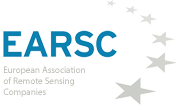The ESA Council of Ministers meets this week in Seville to approve the programme plans of ESA and especially the budget allocations. EARSC has issued a statement supporting the ESA proposals and especially those linked to Future EO, Copernicus 4.0, In-cubed+ and for Global Development Assistance. These are all very important for our sector.
Studies have shown that for every €1 invested through ESA, a return of €3.8 is generated for the Member State. But for Copernicus, the benefit is a great deal higher as government is not only a sponsor but also a key user of the products and services which are generated. As a result, this benefit rises to €10 in socio-economic for European society in return for every €1 invested.
The EO services sector is crucial to delivering these returns. This is illustrated through 2 studies which EARSC has conducted and is conducting. The first looks at the European EO Services industry sector through our biennial survey of the industry. The industry comprises over 515 companies throughout Europe, with 8,400 employees delivering over €1.2b of revenue. The sector is growing at a rate of 10% per annum. The report is available on our web-site.
In this we find that the government sector makes up 65% of the revenue base for the sector. Of this 15% is for R&D actions and 50% represents government buying services to meet its own needs. Now maybe up to half of the R&D spend will also be in support for meeting government needs so we can safely say that more than 50% of the market is to meet government geospatial needs – ie government as a user. It also means that government provides around 10% of the total sector revenue as a sponsor for the sector. It is highly important to clearly distinguish these two roles.
In the study - SeBS; Sentinel Benefits Study - we work to analyse cases where Sentinel data is being used operationally to deliver benefits to a whole value chain; at the head of which is what we refer to as the Primary User. Our approach is to look at the use of a single product or service by this primary user and how that impacts along a value-chain. We have looked in detail at 8 cases so far which show a combined socio-economic benefit of over €200m per annum. But, in most of these the full potential has not yet been reached and both market and technology development will increase the use and value of the services. For these 8, we can identify a minimum potential of an additional €100m.
Furthermore, each case is based on one country and by extending the service to other countries, the benefits will grow significantly. We do not yet have enough evidence to support the further geographical extrapolation but it does seem to more than support the 10:1 benefit ratio given at the outset and can most likely justify an even higher figure.
As we analyse more cases, we plan to address the question of extrapolation and we shall also extend the consideration of benefits to other dimensions such as better regulation, innovation and entrepreneurship creating new jobs and the contribution to scientific advancement. These will go along with the socio-economic benefits and also the socio-environmental ones.
The European EO services industry works alongside ESA to exploit the investments made in the upstream sector. The subsequent downstream benefits are significant, and we really encourage ESA ministers to support the ESA investment plans and agree the new programme proposals to be tabled in Seville. The stakes are high to maintain a European lead in the sector but then the return on investment to Europe is very high.

This page has no comments.